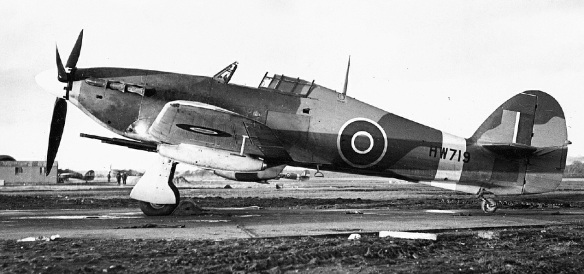Hurricane IId, HW719, seen while serving with the Specialised Low Attack Instructors School, a training unit for ground-attack pilots, at RAF Milfield, in early 1943. It is armed with a pair of Vickers ‘S’ 40mm cannon under its wings and despite the streamlined fairings, this weapons fit had a noticeable drag-inducing effect on the aircraft’s performance.
Close-up detail of a Vickers ‘S’ 40 mm cannon. This gun first saw action in the Western Desert from June 1942 following the delivery of twenty-seven of them to that theatre where both they and their installations worked almost flawlessly, any problems encountered being due to the ammunition itself, some of which it was discovered had not been filled with propellant! Rolls-Royce also developed a 40mm cannon and an order for 1,000 was placed in early 1942, however, for a number of reasons this gun proved overly sensitive during air firing trials and the order was cancelled despite the completion of 200 sets of components. None of the RR guns entered service in an airborne capacity. Each ‘S’ gun carried a fifteen-round magazine with an additional round inside the chamber and used armour-piercing (AP) or high-explosive (HE) shells according to need. The AP round proved effective against all tanks other than Tigers, and was even known to be capable of penetrating the long-barrelled 75mm gun of a Panzer IV. The HE round was found to be particularly effective in the Far East against Japanese ‘soft’ targets and, surprisingly, against Japanese tanks too, albeit the latter’s armour was much thinner than that on German tanks. The 40mm AP Mk.I shell weighed 2lb.7oz and could penetrate 50mm of armour at an angle of 30° to normal flight. In 1943 the AP Mk.V shell entered service, it weighed 3lb – increasing penetration values by approximately 10 per cent. Although the Vickers ‘S’ was undoubtedly successful, and accurate, rocket projectiles were considered to be more useful tactically as, round-for-round, they were more destructive; moreover, once a fighter had released its RPs (or bombs) it could in theory revert to a fighter role without pause, whereas 40mm-equipped Hurricanes remained very vulnerable.
The Vickers Class ‘S’ 40mm gun was developed in the late 1930s as an aircraft weapon, albeit intended for bomber defence and tested as such in a turret fitted to a modified Vickers Wellington II. In the event it wasn’t adopted for bombers, however, once trials at Boscombe Down in September 1941 with Hurricane IIb Z2326 proved successful, it was adopted as an airborne anti-tank gun with special armour-piercing ammunition. Rolls-Royce also developed a 40mm gun, but it never served as an airborne weapon.
The first squadron to be equipped with Hurricanes fitted with two Vickers 40mm guns, mounted one beneath each wing in conformal fairings, was No.6 Squadron, in the Western Desert in June 1942 where they achieved considerable success, although they also suffered heavy losses, mainly to ground fire. The designation applied to these 40mm gun-armed Hurricanes was Mk.IId – basically a modified 1,280hp Merlin XXII-powered Hurricane IIc with the 20mm cannon removed. A pair of wing-mounted .303 inch mgs were installed – used primarily for ranging and sighting purposes, but also to keep the heads of enemy gunners down – and shackles fitted to take the 40mm gun packs. At least three UK-based squadrons operated the type, No.184 being the first, forming at Colerne, Wiltshire, in December 1942, and Nos.137 and 164 Squadrons, which were only partially equipped with the sub-type in 1943, pending receipt of the ‘multi-role’ Hurricane IV.
Number 20 squadron, based in the Far East, re-equipped with the Mk.IV in May 1943, equipped with 40mm cannon firing high explosive (HE) ammunition against road and river transports. Tests (undertaken in the Far East) showed a high level of accuracy for the weapon, with an average of 25% of shots fired at tanks striking the target. Attacks with HE were twice as accurate as with Armour Piercing (AP) rounds, possibly because the ballistics were a closer match to the .303 inch mgs used for sighting (the HE shell was lighter and was fired at a higher velocity). By comparison, the practice strike rate of the 60lb rocket projectiles (RP) was only 5% against tank-sized targets.
A new universal wing was developed for the Hurricane, which had the ability to take various loads such as the 40mm gun, up to two 500lb bombs, Smoke Laying Canisters and Rocket Projectiles. The fitting of a more powerful 1,620hp Merlin 24 or 27 engine, and an additional 350lb of armour plate, resulted in a slightly re-shaped underside radiator housing. Initially designated as the Hurricane IIe, it was quickly changed to become the Hurricane IV.
